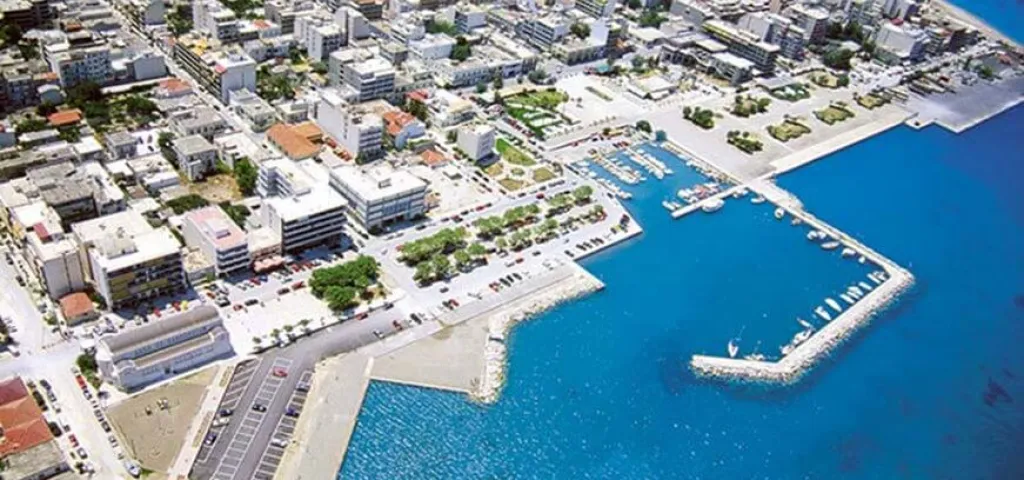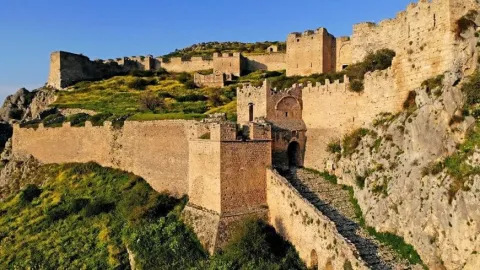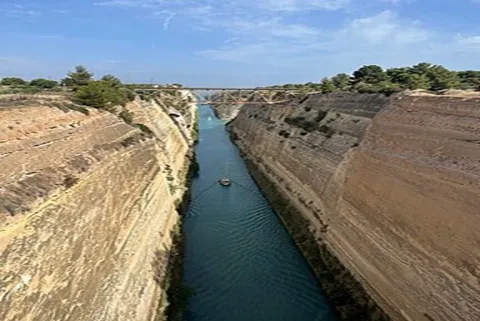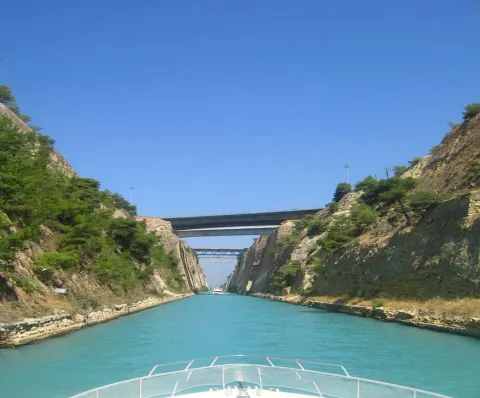
Corinth (Korinthos), is the successor to an ancient city, and is a former municipality in Corinthia, Peloponnese, which is located in south-central Greece. Since the 2011 local government reform, it has been part of the municipality of Corinth, of which it is the seat and a municipal unit. It is the capital of Corinthia.
It was founded as Nea Korinthos or New Corinth, in 1858 after an earthquake destroyed the existing settlement of Corinth, which had developed in and around the site of ancient Corinth.
Corinth derives its name from Ancient Corinth, a city-state of antiquity. The site was occupied from before 3000 BC.
Historical references begin with the early 8th century BC, when Corinth began to develop as a commercial center. Between the 8th and 7th centuries, the Bacchiad family ruled Corinth. Cypselus overthrew the Bacchiad family, and between 657 and 550 BC, he and his son Periander ruled Corinth as the Tyrants.
In about 550 BC, an oligarchical government seized power. This government allied with Sparta within the Peloponnesian League, and Corinth participated in the Persian Wars and Peloponnesian War as an ally of Sparta.
After Sparta's victory in the Peloponnesian war, the two allies fell out with one another, and Corinth pursued an independent policy in the various wars of the early 4th century BC. After the Macedonian unification of Greece, the Acrocorinth was the seat of a Macedonian garrison until 243 BC, when the city joined the Achaean League.
Nearly a century later, in 146 BC, Corinth was captured and was completely destroyed by the Roman army.
As a newly rebuilt Roman colony in 44 BC, Corinth flourished and became the administrative capital of the Roman province of Achaea.
In 1858, the old city, now known as Ancient Corinth (Archaia Korinthos), located three kilometres (two miles) southwest of the modern city, was totally destroyed by a magnitude 6.5 earthquake. New Corinth (Nea Korinthos) was then built to the north-east of it, on the coast of the Gulf of Corinth. In 1928, a magnitude 6.3 earthquake devastated the new city, which was then rebuilt on the same site.
In 1933, there was a great fire, and the new city was rebuilt again.
During the German occupation in World War II, the Germans operated a Dulag transit camp for British, Australian, New Zealander and Serbian prisoners of war and a forced labour camp in the town.
City Sights
Acrocorinth Fortress

'Τhe acropolis of ancient Corinth' is a monolithic rock overseeing the ancient city of Corinth, Greece. In the estimation of George Forrest, "It is the most impressive of the acropolis of mainland Greece."
With its secure water supply, Acrocorinth's fortress was repeatedly used as a last line of defense in southern Greece because it commanded the Isthmus of Corinth, repelling foes from entry by land into the Peloponnese peninsula.
The Acrocorinth was continuously occupied from archaic times to the early 19th century. Along with Demetrias and Chalcis, the Acrocorinth during the Hellenistic period formed one of the so-called “Fetters of Greece” – three fortresses garrisoned by the Macedonians to secure their control of the Greek city-states.
The city's archaic acropolis was already an easily defensible position due to its geomorphology; it was further heavily fortified during the Byzantine Empire as it became the seat of the strategos of the thema of Hellas and later of the Peloponnese. It was defended against the Crusaders for three years by Leo Sgouros. Afterwards it became a fortress of the Frankish Principality of Achaea, the Venetians, and the Ottoman Turks.
Three circuit walls formed the man-made defense of the hill. The highest peak on the site was home to a temple to Aphrodite. The temple was converted to a church, which in turn was converted to a mosque.
The American School's Corinth Excavations began excavations on the Acrocorinth in 1929. Currently, it is one of the most important medieval castle sites of Greece.
Corinth Canal (Dioryga tis Korinthou)

The Corinth Canal (Dioryga tis Korinthou) is an artificial canal in Greece that connects the Gulf of Corinth in the Ionian Sea with the Saronic Gulf in the Aegean Sea.
It cuts through the narrow Isthmus of Corinth and separates the Peloponnese from the Greek mainland, making the peninsula an island. The canal was dug through the Isthmus at sea level and has no locks.
It is 6.4 kilometres (4 miles) in length and only 24.6 metres (80.7 feet) wide at sea level, making it impassable for many modern ships. It is currently of little economic importance and is mainly a tourist attraction.
The canal was initially proposed in classical times and a failed effort was made to build it in the 1st century AD. Construction recommenced in 1881 but was hampered by geological and financial problems that bankrupted the original builders. It was completed in 1893, but, due to the canal's narrowness, navigational problems and periodic closures to repair landslides from its steep walls, it failed to attract the level of traffic expected by its operators.
Isthmus of Corinth

The Isthmus of Corinth is the narrow land bridge which connects the Peloponnese peninsula with the rest of the mainland of Greece, near the city of Corinth. The Isthmus was known in the ancient world as the landmark separating the Peloponnese from mainland Greece.
To the west of the Isthmus is the Gulf of Corinth, and to the east the Saronic Gulf.
Since 1893 the Corinth Canal has run through the 6.4 km (4 mi) wide isthmus, effectively making the Peloponnese an island.
Today, two road bridges, two railway bridges and two submersible bridges at both ends of the canal connect the mainland side of the isthmus with the Peloponnese side.
Also a military emergency bridge is located at the west end of the canal.
Must see attractions
• The seaside zone, especially around the El. Venizelos square with the impressive statue of Pegasus and the small port of Floisvos with the marina. Close by, you will find Kalamia, an extensive and established pebble strewn beach, with many coffee shops and taverns all along it.
• The pedestrian walkway on Pilarinos Zografos Street is a much frequented meeting place for the residents with stores, coffee shops and bars.
• The central Perivolakia square – park with the coffee shops and restaurants is the ideal location for stopping and resting. Across the road (on Ethnikis Antistasis Street) is the city’s impressive Court House, while the statue of Archbishop Damascenus (1890-1949) stands at the small square precisely in front of the Courts.
• The Apostolos Pavlos (Apostle Paul) metropolitan church, on the street of the same name, which was built after the 1928 earthquakes. The “Apostle to the Nations” lived and taught here for a short period and is the city’s patron saint.
• The Historic-Folklore Museum (close to the El. Venizelos square), with exhibits of 3,500 18th and 19th century costumes from all over Greece.
• The Ecclesiastical Museum was established in 1973 and contains significant ecclesiastical exhibits (manuscripts, high priest vestments, portable icons, gospels, photographs etc).
• The Municipal lending Library (84 Pilarinos Street), with notable collections and the Municipal Art Gallery (4 Kolokotroni Street).
USEFUL INFORMATION
- USEFUL TELEPHONES
-
EMERGENCY CALL 112
FIRST AID 166
POLICE 100
FIRE DEPARTMENT 199
CORINTH GENERAL HOSPITAL +30 27410 61400 & +30 27410 25711
CORINTH PORT AUTHORITY +30 27410 28888
CORINTH BUS STATION +30 27410 75410
CORINTH RAILWAY STATION +30 27410 22520
RADIOTAXI CORINTH 18300
RADIO TAXI KORINTHOS +30 27410 73000 - CORINTH HOTELS
-
APOLLON FILOXENIA HOTEL +30 27410 25920
KORINTHOS HOTEL +30 27410 26701
HOTEL ACROPOLIS +30 27410 21104
EPHIRA HOTEL +30 27410 22434

